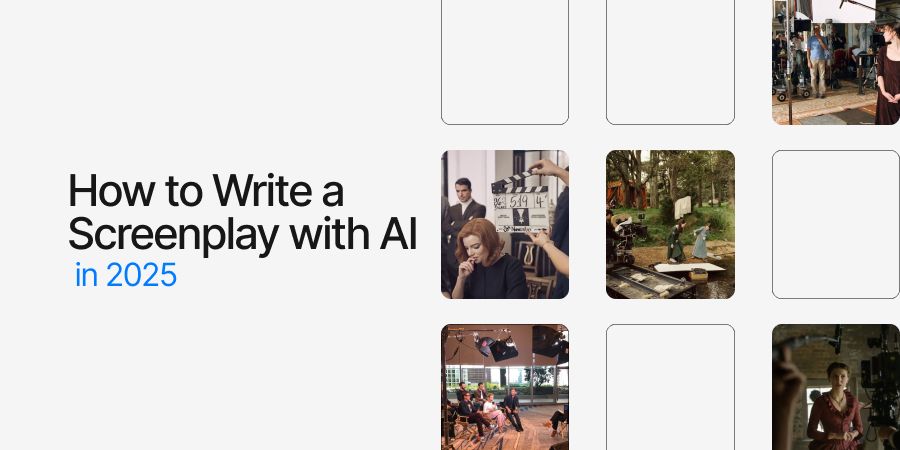
How to Write a Screenplay with AI in 2025
Ever wondered how screenwriters keep scenes tight and dialogue sharp without losing creative flow?
That’s where AI tools now step in. Writing a screenplay with AI combines structure, speed, and imagination, making the process less intimidating for beginners and more efficient for professionals.
Google search data shows queries like “AI screenplay example” and “how to write a screenplay with AI” are climbing, proving more writers are exploring automation for creative work. A screenplay has strict formatting rules, and even minor errors can distract readers.
AI helps eliminate those issues by generating clear outlines, refining dialogue, and ensuring every scene follows industry standards.
A screenplay created with AI is not just faster to produce, but also stronger when paired with a writer’s vision. Instead of getting stuck on blank pages, you can use prompts to create:
-
Act structures that follow the three-act or five-act format.
-
Character arcs that evolve naturally across the story.
-
Dialogue that sounds human, paced, and believable.
-
Scene directions that remain vivid without becoming heavy-handed.
Writing screenplays with AI does not replace creativity. It gives writers control over their time, leaving more energy for building original stories.
Understanding Screenplay Basics
Before using AI to write screenplays, it helps to understand what makes a screenplay different from other forms of writing. A screenplay is not just a story written in paragraphs. It is a blueprint for film or television production, where every page equals roughly one minute of screen time.
Standard Screenplay Format
Industry standards shape how screenplays look and read. Without proper formatting, even the strongest idea risks being ignored. Writers must pay attention to:
-
Font and spacing – Courier 12-point, double-spaced for dialogue, single-spaced for descriptions.
-
Scene headings (sluglines) – Written in all caps, indicating location and time, such as INT. COFFEE SHOP – DAY.
-
Action lines – Describe what happens visually, never what characters think unless shown.
-
Dialogue – Centered, always tied directly to a character’s name above it.
-
Parentheticals – Short instructions for delivery, kept minimal.
Core Elements of a Screenplay
Beyond format, certain elements shape the reading experience:
-
Plot structure – Most screenplays follow a three-act or five-act model.
-
Character development – Strong scripts show clear arcs and motivations.
-
Conflict and tension – Every scene must serve a purpose and move the story forward.
-
Visual storytelling – Focus on what the audience will see and hear, not abstract thoughts.
Why Ignoring AI Won’t Help
Writers often get overwhelmed balancing story, pacing, and technical formatting. AI tools can:
-
Automatically create act structures based on prompts.
-
Suggest sluglines and scene transitions.
-
Refine dialogue into natural exchanges.
-
Check for industry-standard formatting in seconds.
Mastering screenplay basics gives AI the right foundation to generate drafts that meet professional standards.
Step by Step Guide to Writing a Screenplay with AI
Writing a screenplay with AI works best when you treat the tool as a structured partner rather than a shortcut. Every stage, no matter if it is research, planning, drafting, or editing, can be supported by AI to make the process more efficient and consistent.
Step #1 - Research and Inspiration
Good screenplays start with context. AI search tools can scan film databases, script examples, and storytelling guides to highlight trends in structure and dialogue. Writers use this to study genre conventions, character arcs, and scene pacing.
-
Gather references from classic and modern films.
-
Look for examples of how themes are expressed through dialogue.
-
Use AI summaries of script samples to identify common beats.
Step #2 - Building the Screenplay Outline
AI chat platforms can generate outlines that act as a blueprint for scenes and acts. By setting clear instructions, writers can receive a list of acts, turning points, and character developments in screenplay format.
-
Ask for three-act structures with inciting incidents, midpoints, and climaxes.
-
Experiment with different story arcs to see which fits best.
-
Refine the outline until each act flows naturally into the next.
Step #3 - Drafting Scenes with AI Support
When it comes to scene writing, AI can handle the heavy lifting of formatting and dialogue testing. Writers input character details, settings, and tone. AI then generates draft scenes that already follow screenplay standards.
-
Create dialogue that matches character personality.
-
Add stage directions and camera cues.
-
Revise output to ensure emotional authenticity and originality.
Step #4 - Refinement and Polishing
AI cannot replace the writer’s judgment, but it can help with editing. Writers can request tone adjustments, remove redundancy, or expand emotional beats. This ensures the screenplay reads clean and professional.
-
Use AI to cut long dialogue into sharper exchanges.
-
Check consistency in formatting across all pages.
-
Test different tones for the same scene to find the strongest version.
Examples of Screenplays Written with AI
Writers often look for proof that AI can support real screenplay writing. Across genres, AI tools already produce outlines, scenes, and full-length scripts that mirror industry standards.
These examples show (a glimpse of) how AI screenplay generators deliver value.
Short Films
Independent creators use AI to draft shorts under 15 minutes. A single prompt can generate a story arc, dialogue, and stage directions. Writers then polish to add originality.
-
AI produces quick first drafts.
-
Scene pacing fits standard short-film structures.
-
Dialogue flows naturally when refined with edits.
Genre-Specific Drafts
AI handles genre rules well because it pulls patterns from countless samples. A thriller prompt will naturally include tension and reveals, while a romantic comedy draft highlights playful dialogue.
-
Thrillers gain consistent pacing of suspense.
-
Comedies show strong setup and punchline timing.
-
Sci-fi drafts carry layered world-building faster.
Educational Projects
Film students often struggle with structure. AI-generated outlines make it easier to see how acts and beats align.
-
Clear act breakdowns reduce confusion.
-
Sample scripts give reference material.
-
Students practice editing instead of guessing structure.
Professional Use Cases
Writers under deadlines use AI to speed up drafts. They may request dialogue passes, scene summaries, or alternative endings.
-
Saves time on brainstorming.
-
Expands creative range with multiple variations.
-
Keeps formatting aligned with industry tools.
These examples prove that AI is not just a novelty. Screenwriters, students, and indie creators already rely on it to accelerate their work, test different approaches, and polish scripts into production-ready drafts.
Best AI Tools for Screenplay & Script Writing
Writers experimenting with AI screenplay tools often look for more than formatting – they need structure, story support, and dialogue assistance.
Below is a list of leading screenplay generators, including what each tool is best for and where to access it.
1. Chatly — www.chatlyai.app
Chatly combines AI chat, AI search, and multiple model access. It is best for screenplay writers who want to research themes, build outlines, and draft scenes across different tones.
It supports models from OpenAI, Anthropic, Gemini, and Grok, making it versatile for both character-heavy scripts and narrative-driven projects.
2. Sudowrite — www.sudowrite.com
Sudowrite is a creative writing AI that specializes in expanding short drafts into full narrative scenes. It is best for generating descriptive passages, adding creative twists, and experimenting with multiple dialogue variations in screenplays.
3. Jasper AI — www.jasper.ai
Jasper is designed for content and marketing writing, but with screenplay templates, it helps in drafting professional dialogue and refining scene structure. Best for writers who want polished, production-ready scripts in less time.
4. DeepStory — www.deepstory.ai
DeepStory focuses on AI-driven narrative building for film and TV projects. It generates detailed plotlines and scene suggestions. Best for early-stage writers who want automated plot scaffolding before developing character-specific dialogue.
5. ScriptAI — www.scriptai.com
ScriptAI is purpose-built for screenwriting format compliance. It ensures correct screenplay structure – sluglines, dialogue, and transitions – without requiring manual formatting. Best for writers who need technical accuracy in final drafts.
6. ShortlyAI — www.shortlyai.com
ShortlyAI offers a distraction-free writing space powered by GPT models. It is best for quick drafting of scenes and character monologues, especially when testing multiple creative directions.
7. Rytr — www.rytr.me
Conclusion
AI screenplay generators provide writers with structure, speed, and idea expansion. They make drafting easier by formatting scenes correctly, suggesting dialogue, and even proposing unexpected plot turns.
Tools such as Chatly, DeepStory, Jasper, and ScriptAI are already being used in professional and experimental settings.
A strong screenplay still depends on the writer’s creativity. AI helps generate outlines, fill blank pages, and polish structure, but human judgment refines character depth and story meaning.
Writers who blend AI efficiency with their own craft gain a practical advantage – scripts move faster from idea to production.
Suggested Reads
Frequently Asked Questions
Here’s a list of most repeated questions about writing screenplays using AI.
More topics you may like

How to Write a Cover Letter with No Experience Using AI Chat

Muhammad Bin Habib

How to Write a Case Study, with Examples, Tools and Templates

Muhammad Bin Habib

How to Write AI Art Prompts: A Complete Guide

Muhammad Bin Habib

How to Write a Great Memoir: How to Start & Finish Your First Draft

Muhammad Bin Habib

How to Write a LinkedIn Recommendation in 2025

Muhammad Bin Habib
